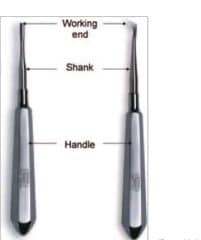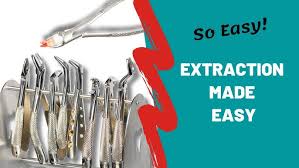Dental extraction forceps have different sizes and shapes. The choice of forceps depends on your preferred tools has a dentist or the instruments that you use more often. Instruments used for dental extraction as a short blade design and a long handle to offer more mechanical support. Most dental extraction forceps come with a primary or baby tooth equivalent.
Types of dental extraction forceps

© aie-dental
Upper forceps have their grips in line with the blades while lower forceps have their handles at right angles to the blade. Blades vary in width, length, and curvature to accommodate the different shapes of the roots.
- Straight forceps – dental extraction forceps are designed to fit and extract front teeth (incisors and canines).
- Upper premolar forceps – have grips that are angled in a mesial direction relative to the blades, so allowing exact alignment of the blades for the premolar tooth. The curve is to avoid the handles from fouling the lower lip or teeth.
- Lower root forceps – all lower dental extraction forceps is designed for extracting roots in the lower posterior area as an angled with their grips at roughly 90 degrees from the blades. This allows a dentist hand to take proper control and power.
- Lower molar forceps – It as two mesial roots which are fused and one distal root. The Beaks are at right angles to the handles. Therefore the forceps will need a twin beak on either side. Third molar or wisdom tooth has variable root pattern.
- Upper molar forceps – upper molar teeth has three roots (two buccal roots and one palatal root). The forceps are twin beaked on the cheek side and have a single blade palatally. Because of the asymmetrical beaks, the instrument is not reversible and separate beaks are needed for right and left.
- Bayonet forceps – It is an extraction type of forceps, designed to reach and extract tissues within deep cavities. It has two blades that have blunt edges.
- Cowhorns forceps – are designed to penetrate in between the roots of molars to split the roots especially if the roots have diverged.
Elevators for dental extraction

© kcsurgical
Elevators are slightly different from the forceps that I mentioned earlier because the dental extraction instruments have three components – handle, shank and blade. These make your dental works easier because the elevators apply force between the tooth and bone. The elevators protect the tooth from a fracture because the force is not transferred to the jaw. Learn more: https://healthsoothe.com/dental-elevators/

Elevators can be used along with forceps to:
- The elevator cut down the tissues that are attached to the supporting tooth,
- It is used for expanding the socket or dilating to facilitate dental extraction instruments,
- allow excess for the forceps to grip further down the root,
- remove root stumps.
These instruments are used to remove impacted third molar teeth with gentle pressure and forces. The couplands elevators as three common patterns. They are Couplands No. 1, 2 and 3, Cryers right and left and Warwick-James right, left and straight.
Scalpel
A Bard-Parker handle with a No. 15 blade is the usual scalpel used to make incisions on the gums where a flap can be raised to gain access to the tooth.
Periosteal elevators
It is similar to the elevator but periosteal elevators are designed with two heads – one at each end. It has a sharp working end at one side that can expand the tooth socket and the other heads has a blunt end to raise a gum flap or remove granulation tissues.
Retractors
Tongue, cheek, and flap retractors are used to gain proper access to the tooth during dental extraction instruments.
Surgical burs

© bicon
The burs are used to remove the bone that is surrounding the tooth to be extracted. It is Used with a straight handpiece, to split the tooth apart.
Chisels And Mallet Dental extraction Instruments
Chisels are normally used in the operating theatre for distoangular third molars and upper wisdom teeth extraction. more appropriate in the operating theatre and are particularly useful
Bone curettes
A bone curette is a dental instrument that removes the tissues. It is a spoon-shaped instrument that removes the growth of tissues from a cavity. It has sharp or blunt edges to remove the tissues.
Bone ronguer and bone file
Used to smoothen any sharp bone edges after a tooth extraction is done.
Needle holders and sutures for dental extraction

© wapedia
Sutures are used to replace and secure the gum flap in its former position, to limit the size of the wound and therefore restrict subsequent contamination with food debris, and to assist in controlling bleeding. The usual suture size for intra-oral work is 4/0 and the material may be absorbable or non-absorbable
Scissors
Dissecting scissors and suture-cutting scissors are usually used.
Artery Forceps
Artery forceps are known as Haemostatic forceps. The hemostat used to blocks the flow of blood and tips close the blood vessels. Its also used to hold the tissue and skin.
Aspirator
This invention relates generally to an aspirating system for use in dentistry and more particularly relates to aspirator tips for removing liquids from a patient’s mouth –including natural liquids (such as saliva) as well as liquids (such as water) supplied as coolants and lubricants for certain cutting tools.
RELATED READING

Isreal olabanji a dental assistant and public health professionals and has years of experience in assisting the dentist with all sorts of dental issues.
We regularly post timely and trustworthy medical information and news on Fitness, Dental care, Recipes, Child health, obstetrics, and more.


